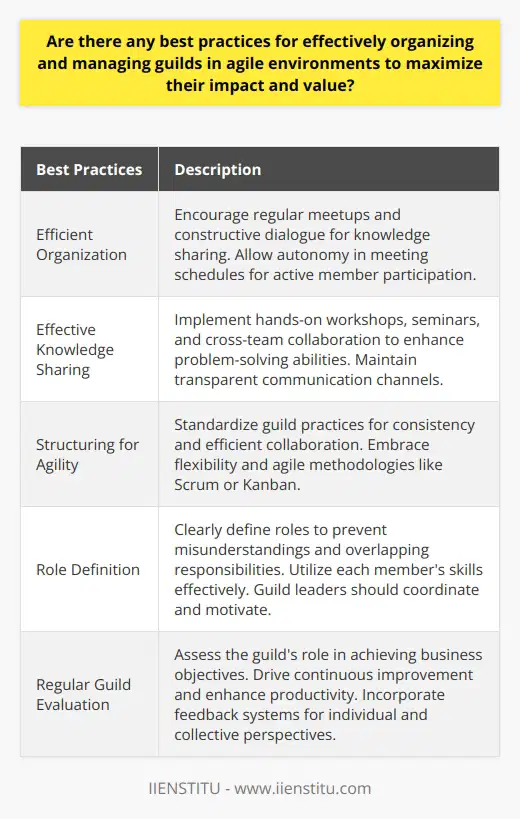
Guilds have been around for hundreds of years and have been associated with collaborative work for centuries. A guild is a group of people who have banded together to pursue a common goal, often a craft or trade.
The earliest known guilds can be traced back to the Roman Empire in the first century A.D. Traditionally; guilds firmly focused on education, collaboration, and mutual respect. Combined with communal accountability and a well-defined structure, these features created an effective strategy for producing high-quality work.
Modern Guild Approach
As technology and the global economy have changed, guilds have evolved to fit a more modern model. In many cases, the traditional aspects of guilds remain but in a more streamlined format. These days, guilds are as likely to be filled with software developers or engineers as they are craftsmen or artisans. Several companies have adopted the process of implementing a guild structure as a way to promote collaboration and better use of resources.
The benefits of this approach are numerous. For starters, guilds motivate members to improve and become more adept at their craft. This creates a more competitive atmosphere within the guild, encouraging members to strive for excellence in their work. Additionally, guilds allow for more efficient workflow by enabling members to draw from a larger pool of resources. Finally, the guild's structure provides a more dynamic project management and communication approach.
Despite the numerous advantages of modern guilds, there are some challenges when putting this system into practice. First, keeping guild members motivated over the long term can be difficult. This is because guilds often need to be faster-moving and require collective consensus. Also, developing a guild structure tailored to a specific type of project can take time and effort. Finally, finding the right balance between autonomy and accountability can be challenging and often requires much adjustment.
Applying Guilds to Product Teams
Guilds offer a unique opportunity for product teams to gain an advantage by leveraging the structure and benefits of a guild. With simple reframing, product teams can become guilds dedicated to creating excellent products. In addition, reframing product teams as guilds offer a new perspective, enabling teams to adopt a more concise workflow and develop a shared sense of purpose.
To make the transition, several steps must be taken. Firstly, team metrics should be aligned with the overall objectives of the guild. This helps to keep team members motivated and encourages them to strive for the best possible outcomes. Regular assessments should also be conducted to assess progress and identify improvement areas. Additionally, team members should be encouraged to practice their craft regularly. This allows guild members to develop skills, build relationships, and engage in collective shenanigans.
Assessing to Measure Success
Regular assessment of guild performance is critical for ensuring success. This assessment should involve both individual and collective evaluation. Guild members should be asked to review their performance and identify improvement areas for the individual assessment. This helps ensure that guild members are actively engaged in the process and that any potential issues are quickly identified.
For collective assessment, the guild should have clear and achievable aims agreed upon by all members. These aims should be assessed throughout the year, and adjustments made to ensure the guild remains on course. This will ensure the guild can continue producing quality products while allowing room for improvement and growth.
Conclusion: Drawing on historical guidance, the advantages of guilds remain as relevant today as they were centuries ago. Guilds offer a unique gift for teams when combined with modern technological advances. Implementing a guild structure can provide numerous benefits, from improved workflows to collectively evaluating aims. It effectively ensures that teams can reach their goals in a collaborative and productive environment. Despite some challenges, those transitioning to a modern guild structure can gain a decisive advantage.
When a group of people works together towards a common goal, the power of the collective can be greater than the sum of its parts.
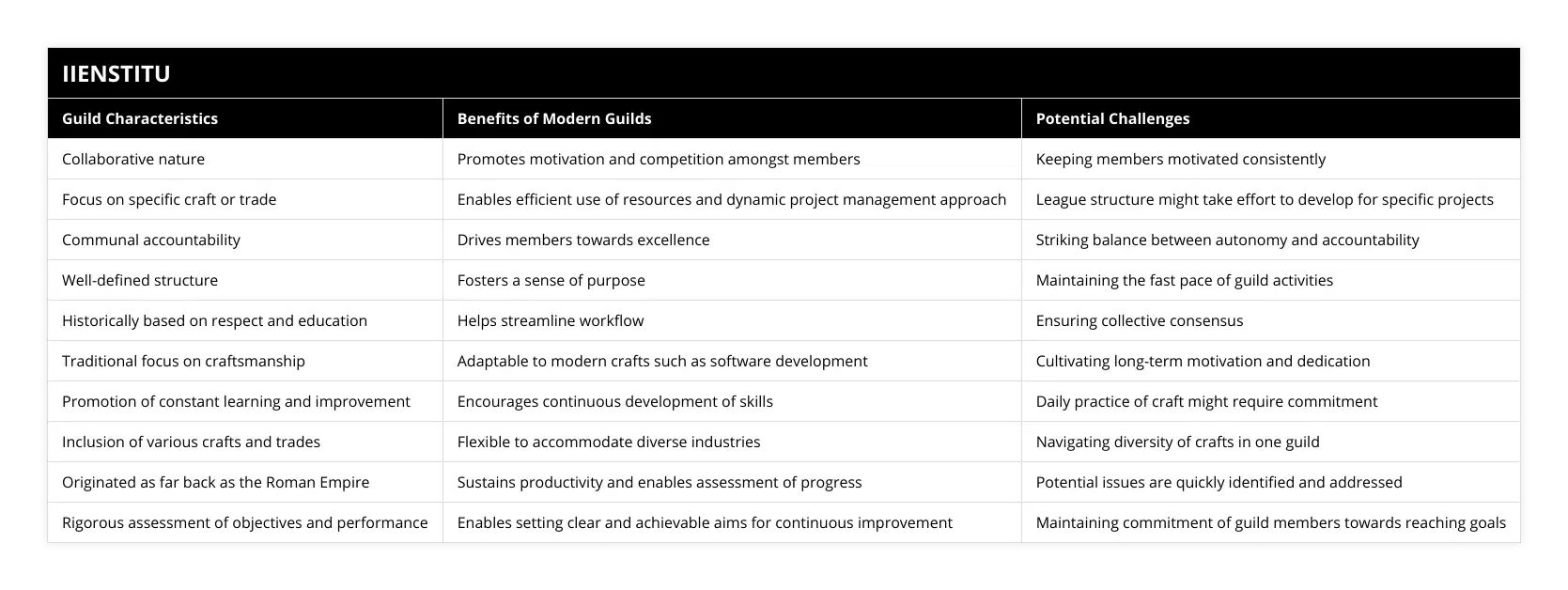
Frequently Asked Questions
How can implementing guilds improve productivity in product teams?
Product teams require a certain level of productivity to meet their goals and ensure their overall success. Implementing guilds can help these teams to improve their productivity and increase the efficiency of their operations. Guilds are small teams of individuals who share comprehensive knowledge and skills in a particular area. By organizing these individuals into guilds, groups can unite them and utilize their collective knowledge, skills, and expertise to create a cohesive system for more efficient collaboration and knowledge sharing. This can be particularly beneficial for teams needing more specialized skill sets.
In addition to increased knowledge sharing, guilds can help foster better relationships between team members and create an environment of collaboration and trust. This can result in a better team atmosphere, leading to increased productivity as individuals are better able to work together and are more motivated to contribute. Additionally, the guilds can provide a platform for feedback and creativity, encouraging individuals to openly share their ideas which can lead to more innovative solutions for team projects. Finally, guilds can create a culture of accountability within the team as individuals have a more direct connection to the objectives being pursued and the goals being achieved.
Implementing guilds into product teams is an effective tool for improving productivity and overall team progress. By providing couples with a collaborative platform that enables easy knowledge sharing and encourages the development of relationships and partnerships, guilds can create an environment where teams can effectively work together and increase their efficiency. In addition, by streamlining the communication process, guilds can create a team atmosphere conducive to productivity, resulting in improved results and tremendous overall success for product teams.
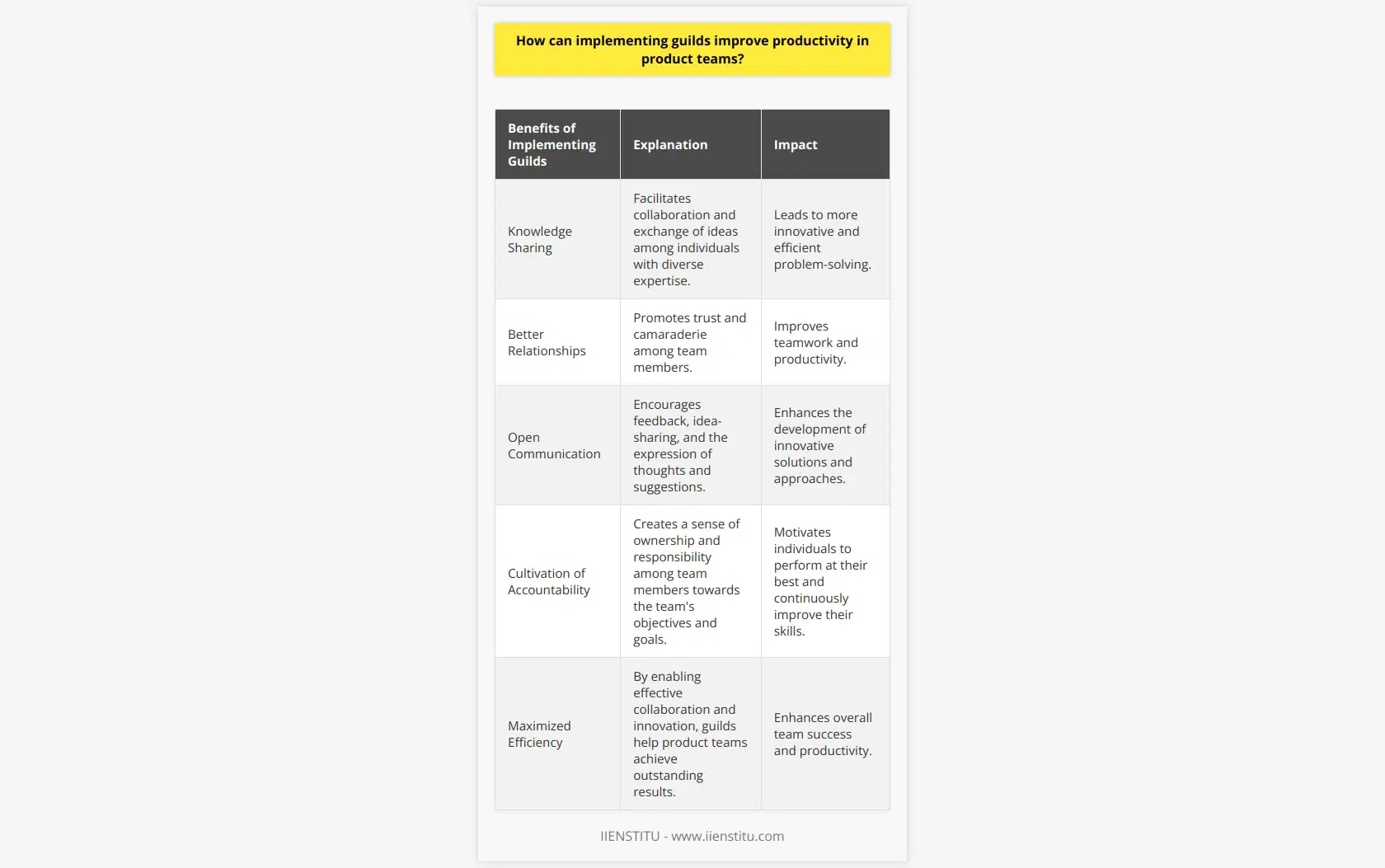
What benefits do guilds provide compared to other team structures?
Guilds, a type of team organization, have many advantages compared to other, more traditional team structures. This article will discuss the benefits of guilds and explain how they can help businesses, organizations, and other entities.
According to research, one of the critical advantages of guilds is the increased level of collaboration between team members. The structure of a guild is that of a deeply interconnected network in which each member clearly understands each other's roles, capabilities, and strengths. As such, members can draw upon each other's skills and knowledge to solve problems and create innovative solutions. In addition, the guild structure of a team removes hierarchy, allowing information to be quickly and easily shared, empowering the team members, and promoting group identity.
Objectives and expectations are also more precise in guild structures. Each member has a particular job within the larger framework of the guild and is held accountable to the team. This clarity allows team members to focus on their tasks and contribute to the team rather than competing against each other.
Another advantage of guilds is that they enable teams to operate with fewer resources. With the increased collaboration among team members, tasks are shared and completed more efficiently than in other structures. Furthermore, since guilds have shared objectives and expectations, teams can maximize their productivity without hiring additional personnel.
Lastly, guilds are more effective at fostering community among team members. As the team works together on shared goals, they create a sense of unity and loyalty that can help ensure the project's success. Guilds also provide a place for team members to receive feedback, build relationships, and socialize.
In summary, guilds offer many advantages compared to traditional team structures. They promote collaboration, foster community, operate with fewer resources, and have more apparent objectives and expectations. For businesses, organizations, or any entity looking to implement a team structure, guilds can provide a highly efficient and effective system.
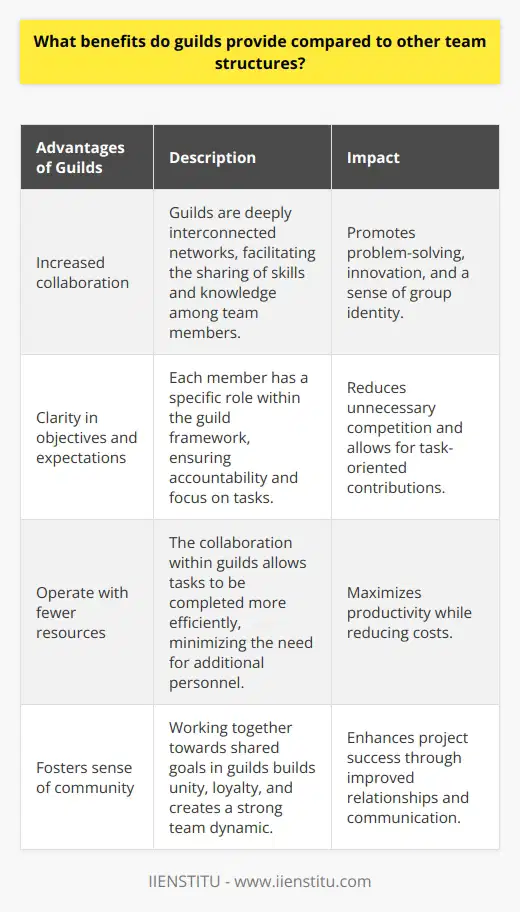
What challenges may arise when introducing guilds to an existing organization?
Introducing guilds to existing organizations is a relatively recent organizational development tool. This approach aims to enhance employee engagement and collaboration and create an environment that encourages knowledge sharing and more opportunities for innovation. However, despite the promise of guilds, introducing them to an organization presents some unique challenges.
One challenge that may arise is resistance to change. Introducing guilds can introduce an entirely new organizational structure and working processes, including new roles and responsibilities. This can be met with resistance from employees used to the existing way of doing things. Therefore, it can be crucial to have clear and effective communication with employees throughout the process to keep them informed, create buy-in, and reduce resistance.
A second challenge is the potential for guilds to be overly hierarchical. To function effectively, guilds must have strong leaders who can act as coaches and mentors. However, these leaders can focus highly on results and view their guild as a closed system. This can lead to an overly centralized decision-making process, limiting the creativity and initiative of guild members and ultimately leading to decreased productivity.
Thirdly, some guilds can need more clear scope and boundaries. Establishing organizational goals for the entire guild can help. Still, these goals can be difficult to define accurately and often require trade-offs between individual and organization-wide objectives. Determining a unified pathway forward can become more difficult as guilds become more complex and expansive.
Taking the time to effectively plan and create organizational goals, model clear leadership roles, and set firm boundaries within guilds helps mitigate any challenges. In addition, planning and communication are essential keys to successful guild implementation and ensuring that all stakeholders are on board and invested in guild success.
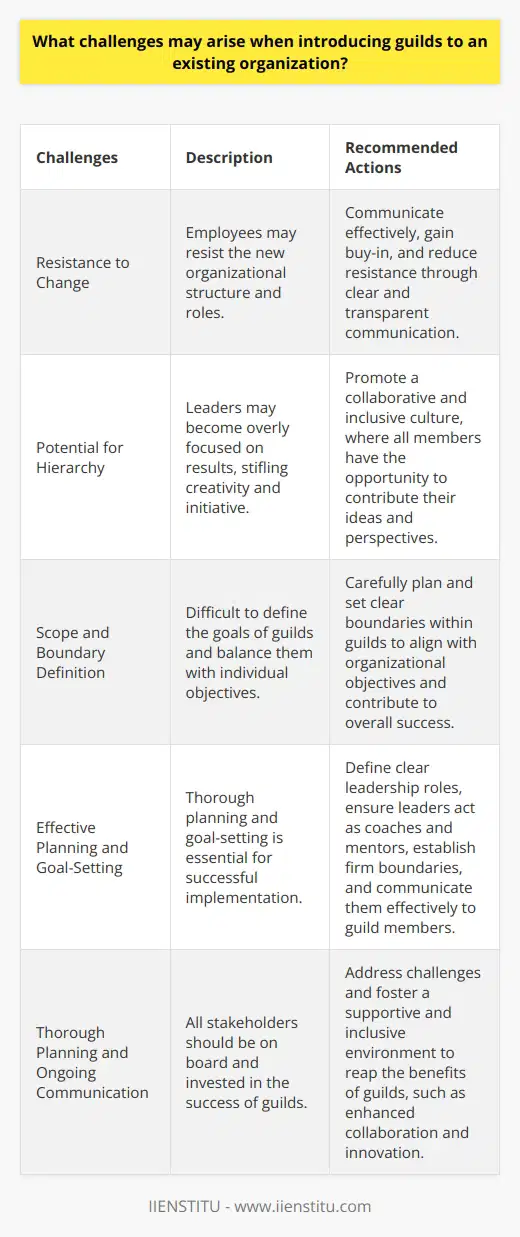
What is the purpose of a guild in the context of agile software development?
Guilds in Agile Development
Purpose of Guilds
In the context of agile software development, the primary purpose of a guild is to foster cross-functional knowledge sharing, collaboration, and continuous improvement among team members with similar skill sets or interests. Guilds offer a platform for these individuals to exchange ideas, discuss challenges, and explore solutions, helping improve the efficiency and performance of not only their specific domain but also the overall software development process.
Enhancing Expertise
Guilds facilitate the diffusion of best practices and expertise among their members, which ultimately contributes to enhanced skills among the entire agile team. The collective knowledge within the guild is used to address issues that require a broader understanding of a specific aspect, such as architectural design, testing, or user experience. Consequently, teams can continuously adapt, learn, and innovate, ensuring a more effective and efficient development process.
Encouraging Collaboration
In addition to the technical know-how, guilds also promote collaboration across different agile teams or squads within an organization. By fostering a culture of communication and openness, these groups are able to share experiences and lessons learned, preventing duplication of efforts and reducing the chance of encountering similar pitfalls. Furthermore, these connections often lead to a more unified and harmonious workplace, enabling higher levels of productivity and engagement.
Supporting Adaptability
The nature of agile development calls for swift adaptability to changes in requirements, technology, and market trends. Guilds play a crucial role in ensuring teams stay up-to-date with the latest industry advancements and techniques by conducting regular meetings, workshops, or training sessions. Through these activities, members of the guild can consistently fine-tune their competencies, ensuring that they are well-equipped to respond effectively to the dynamic landscape of software development.
Facilitating Continuous Improvement
By establishing a consistent platform for dialogue and reflection, guilds contribute significantly to the continuous improvement of an agile team's performance. Through iterative learning, teams can identify shortcomings, correct errors, and optimize processes, driving both individual and organizational growth. This dedication to progress and knowledge sharing leads to greater efficiency, higher code quality, and improved overall software products.
In conclusion, guilds play a vital role in agile software development by fostering an environment of continuous learning, collaboration, and growth. They serve as the backbone of a strong, adaptive workforce capable of delivering high-quality software products in an ever-evolving technological landscape.
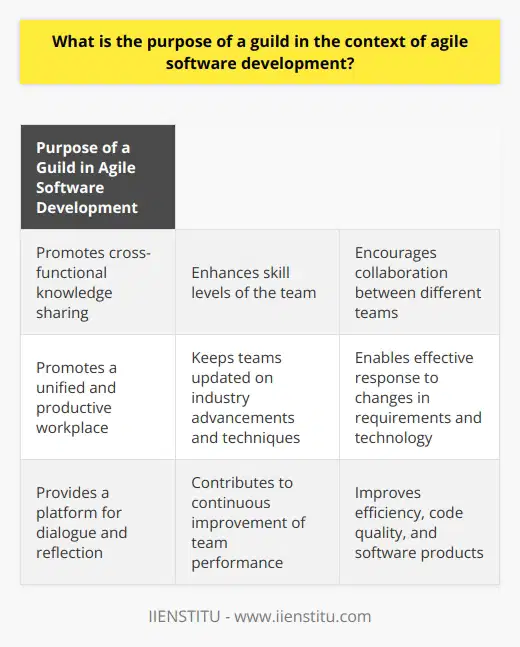
How does a guild in product management facilitate cross-functional coordination and knowledge-sharing?
Guilds in Product Management
Cross-functional Coordination
A guild in product management is a vital tool in facilitating cross-functional coordination, as it serves as a platform that connects team members from diverse areas of specialization. By establishing clear communication channels, guilds enable individuals with varied expertise to bridge gaps, align objectives, and enhance the overall project management process. Additionally, a guild provides a common space for discussions, brainstorming sessions, and decision-making, allowing team members to collaborate effectively and work cohesively toward a shared goal.
Knowledge Sharing
The guild model promotes knowledge-sharing among its members by fostering an environment of continuous learning and improvement. With a guild in place, team members can openly share their experiences, lessons learned, and best practices with colleagues who have similar functional interests. Moreover, a guild fosters a sense of shared ownership, which encourages team members to approach problem-solving collectively and actively seek insights from colleagues with different expertise.
Cross-functional Skill Development
A key benefit of guilds in product management is the promotion of cross-functional skill development, such that team members can gain a broader understanding of various aspects of the product lifecycle. Through regular interactions in guild meetings, workshops, and training sessions, individuals can enhance their abilities, recognize the significance of different roles, and develop empathy towards their colleagues. Ultimately, this cross-functional skill development benefits the entire product management process, as it helps team members function efficiently and make well-informed decisions with a holistic perspective.
Promoting Innovation and Excellence
Guilds in product management stimulate innovation and drive excellence by providing a supportive environment for members to exchange ideas, challenge assumptions, and strive for continuous improvement. This collaborative culture enables team members to embrace creativity, experiment with new ideas, and take calculated risks, fostering a spirit of innovation and agility within product development.
Overall, a guild in product management is instrumental in enhancing cross-functional coordination and knowledge-sharing among team members. These guilds not only help bridge communication gaps but also contribute to a culture of continuous learning and improvement, ensuring that team members can tap into diverse perspectives and promote excellence in their product management processes. In essence, a guild serves as a catalyst for organizational growth and success, ultimately fostering innovative, customer-centric, and effective product management.
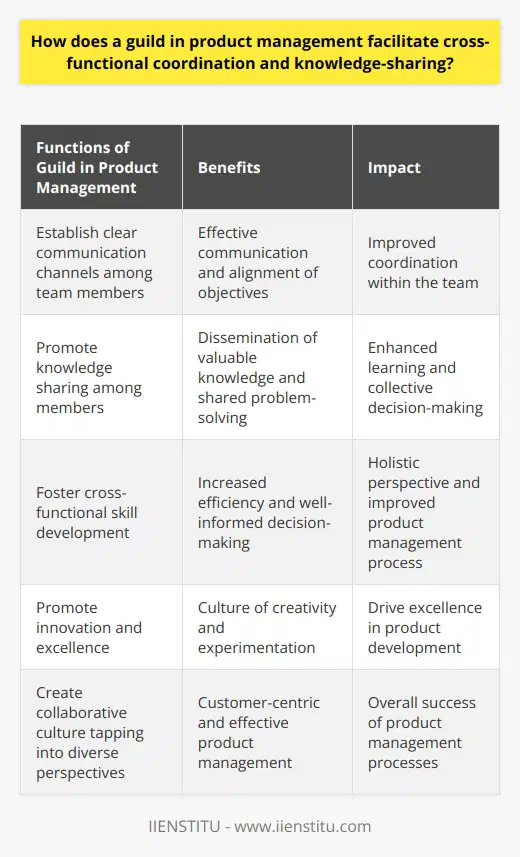
In the Spotify model, how do guilds contribute to fostering innovation and collaboration among individuals with similar expertise?
Function of Guilds
In the Spotify model, guilds play a vital role in supporting innovation and collaboration among individuals possessing similar skills or expertise. Guilds are informal communities that allow members to exchange knowledge, experiences, and ideas, ultimately enabling them to develop their skills and stay up-to-date with industry trends.
Encouraging Knowledge Sharing
One significant way that guilds facilitate innovation is by promoting knowledge sharing among their members. Through regular meetings, workshops, and presentations, individuals can learn from each other's trials and successes. This not only leads to the deepening of domain-specific proficiency, but it also creates an environment in which creativity thrives.
Creating a Supportive Environment
Another crucial aspect of guilds is the establishment of a supportive environment that fosters collaboration among members. Guilds often consist of individuals from different cross-functional teams, which enables the blending of perspectives and aids in problem-solving. The mixing of expertise further pushes members to think differently, seeking innovative solutions to challenges.
Developing Cross-Functional Projects
Guilds also contribute to innovation and collaboration through the initiation of cross-functional projects. These projects often involve members from different teams, uniting them to work towards a common goal or solve a particular problem. As guild members collaborate, they not only share their own expertise, but they also gain a broader understanding of the domain, which can promote the exploration of new ideas and techniques.
Promoting Continuous Learning and Growth
Finally, guilds encourage continuous learning and personal development among their members. Through regular engagement and exposure to different ideas, individuals are inspired to seek new ways of applying their expertise in their ongoing work. This continuous growth mindset ultimately contributes to the overall innovative and collaborative culture within the organization.
In conclusion, guilds within the Spotify model play an integral role in fostering innovation and collaboration by supporting knowledge sharing, creating a supportive environment, promoting cross-functional projects, and encouraging continuous learning among individuals with similar expertise. It is through these practices that guilds can help drive the evolution and improvement of skills and processes, leading to overall organizational success.
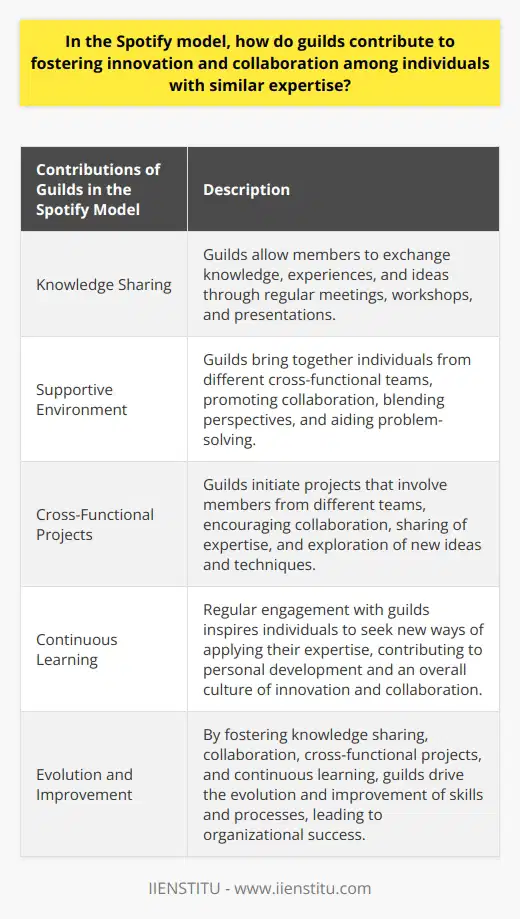
What is the guild model and how does it differ from traditional team structures in agile environments?
Defining the Guild Model
The guild model signifies a collaborative approach in agile environments that goes beyond traditional team structures by fostering cross-functional knowledge sharing and personal development. Designed to nurture adaptive learning and strengthen weak areas, guilds act as a supportive network for employees.
Key Differences Between Guild Model and Traditional Team Structures
Focus on expertise and skill development
Traditional team structures often emphasize separate functions, with team members possessing specialized skills and focusing on their respective areas. In contrast, the guild model promotes continuous learning and cross-functional expertise through collaboration with colleagues possessing diverse skills and experiences.
Decentralized decision-making process
Unlike traditional hierarchies, guilds allow a more decentralized decision-making process, enabling individuals at various levels in the organization to contribute and influence decisions. This increased flexibility and adaptability ensure that teams can address problems more efficiently and meet the changing needs of the project or organization.
Enhancement of problem-solving capabilities
The guild model encourages employees to seek insights from a wider pool of knowledge and experience than traditional team structures. This shared understanding enables teams to achieve comprehensive solutions to complex problems, thereby enhancing agility and adaptability in the workplace.
Facilitation of cross-team collaboration
Traditional team structures often reinforce silos, preventing effective collaboration between teams. Guilds, on the other hand, create an environment in which members from different teams come together, communicate openly, and exchange insights, experiences, and best practices, ultimately fostering a culture of innovation.
Employee-driven learning and growth
In traditional team structures, learning and development opportunities are often constrained by job functions and roles. With the guild model, employees are empowered to explore skillsets, learn from their peers, and pursue their interests, resulting in a more motivated and self-driven workforce.
In conclusion, the guild model presents an alternative to traditional team structures in agile environments, offering several advantages by promoting cross-functional collaboration, decentralized decision-making, and employee-driven learning. This innovative approach encourages a culture of continuous improvement and agility, enabling organizations to remain competitive and adapt to dynamic market conditions.
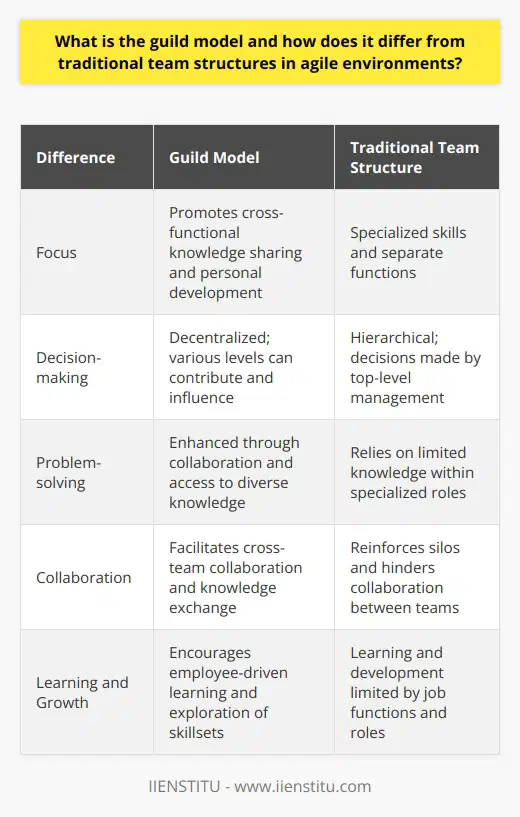
How do guilds function within the product development process to enhance collaboration and communication across different teams?
Role of Guilds in Product Development
Guilds, as informal organizational structures within product development processes, serve as valuable tools to foster collaboration and communication among diverse teams. They achieve this through various means, which include regular meetings, shared practices, and constant knowledge exchange.
Regular Guild Meetings
In many organizations, guilds host routine gatherings that bring together members from various teams to discuss pertinent issues, share new ideas, and brainstorm solutions to common problems. These meetings cultivate an environment of openness and trust that encourages cross-functional communication and teamwork.
Shared Practices and Standards
Guilds promote the establishment and dissemination of standard practices, guidelines, and tools across different teams. By creating a common ground for all members to work with, they ensure a coherent and consistent approach to product development, thereby reducing misunderstandings and increasing overall efficiency.
Knowledge Exchange and Continuous Learning
As a forum for knowledge sharing, guilds enable individuals to gain insights from the experiences and expertise of their peers. Through workshops, mentorships, and shared resources, members have access to an extensive knowledge base that drives continuous learning and professional development.
Bridging Communication Gaps
Embedded within disparate teams, guild members act as essential communication bridges, enhancing the flow of information across the organization. By fostering strong relationships among teams, guilds ensure seamless collaboration and the effective integration of diverse perspectives, ultimately contributing to the successful development of products.
In conclusion, guilds play a crucial role in enhancing collaboration and communication across different teams within the product development process. By facilitating meetings, promoting shared practices, enabling knowledge exchange, and bridging communication gaps, they contribute significantly towards creating a conducive atmosphere for product innovation and growth.
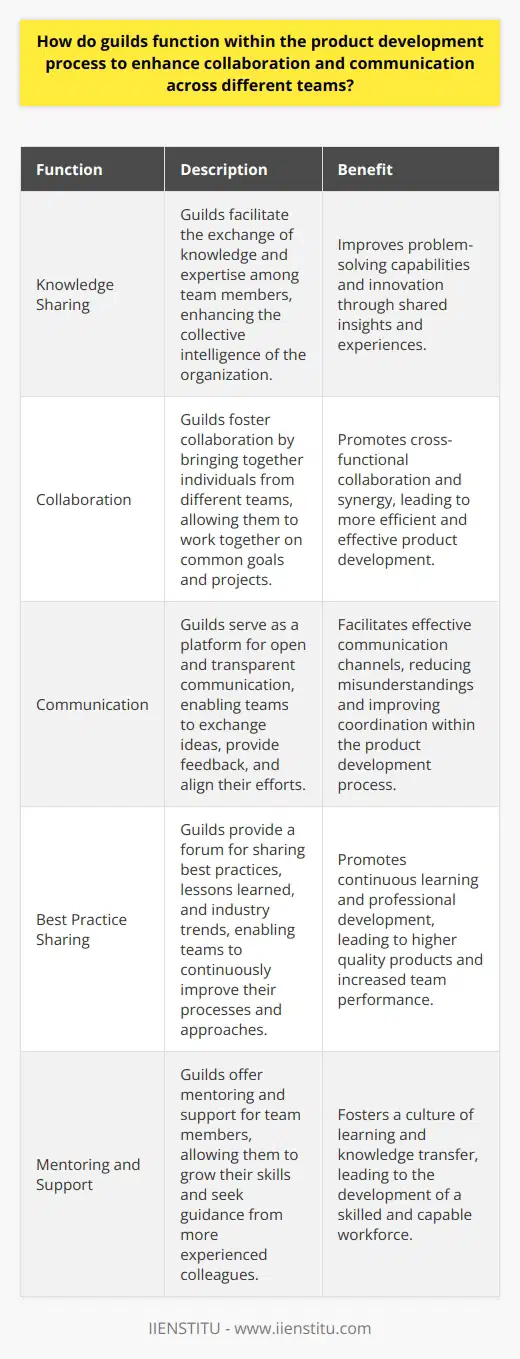
Can you provide a real-world case study that demonstrates the successful implementation of guilds in an agile organization?
Real-World Example: Spotify's Agile Guilds
Background and Context
One notable case study that exemplifies the successful implementation of guilds in an agile organization is Spotify. Spotify revolutionized the music streaming industry by adopting an innovative organizational model rooted in agile principles called the Spotify Model.
Formation of Guilds
In the Spotify Model, employees are divided into small, autonomous, cross-functional teams called squads. Each squad has a specific mission and is empowered to achieve its goals independently. Alongside squads, Spotify established an additional layer of communication and collaboration called guilds.
Objectives and Functions
A guild is a group of people across different squads who share common interests, expertise, or responsibilities. They are created to facilitate knowledge sharing, problem-solving, and continuous improvement within a specific domain. Guilds provide a platform for employees to navigate challenges and gain insights by learning from one another through networked learning.
Impact on Agility
Spotify's agile guilds help promote a culture of continuous learning and improvement, where employees can share best practices, tools, and resources. Guilds encourage a sense of shared ownership and commitment to excellence, which ultimately contributes to the overall effectiveness and productivity of the organization.
Success Factors
The successful implementation of guilds at Spotify can be attributed to several factors. Firstly, effective communication plays a pivotal role in the functioning of these guilds. Regular guild meetings facilitated discussions, enabling people from different squads to share their experiences and learn together.
Secondly, Spotify fostered a culture of trust and autonomy within guilds. Squad members felt empowered and motivated to be part of guilds voluntarily, thus making their involvement more meaningful and effective.
Thirdly, the company provided necessary resources and support for guild activities, such as arranging for experts and speakers to offer insights and advice. This helped create an enriching experience for the employees and kept them engaged.
Conclusion
Spotify's experience demonstrates that guilds, when implemented effectively, can contribute significantly to an agile organization's success. Guilds provide employees with opportunities for learning, networking, and professional development, which help them adapt and grow in a rapidly evolving business landscape. This real-world example of Spotify's agile guilds showcases the potential of incorporating guilds into other agile organizations looking to foster collaboration and drive continuous improvement.

What is the role of a guild in fostering continuous learning and skill development for agile practitioners?
Guilds as Learning Platforms:
A guild serves a pivotal role in promoting constant learning and skill development among agile practitioners. It fosters a shared learning environment. Here, professionals can exchange insights, experiences, and best practices. They can also develop their skills by handling shared challenges.
Continuous Improvement in Agile:
In the agile world, where adaptability and continuous improvement are essential, guilds form a mechanism for ongoing learning. Agile practitioners must constantly innovate and adapt. Through guilds, they get opportunities to learn from peers, mentors, and experts.
Community-Based Learning:
A guild acts as a community-based learning platform. It allows practitioners to learn from real-world experiences and context-specific practices. This form of learning can be more effective than traditional training programs. Members can directly apply the acquired knowledge to their work environments, thus enhancing their agility.
Guilds and Skill Development:
Furthermore, guilds can often facilitate the development of a broad spectrum of skills. They are not limited to technical abilities. They encompass leadership, teamwork, communication, among others. This form of skill diversification is of immense value in the agile domain as it emphasizes the importance of versatility and cross-functional abilities.
Guilds as an Innovation Platform:
Moreover, guilds can stimulate innovation. They enable the cross-fertilization of ideas and aggregated problem-solving. Insights gained from such platforms can help practitioners to refine their agile approach.
In conclusion, a guild helps in cultivating a collaborative, learning-centric, and innovative milieu. It exposes agile practitioners to varied perspectives, enriching their skillsets, and promoting continuous learning.
Word count: 199

How do guilds within the Spotify model promote a culture of ownership and autonomy among team members?
Guilds and Spotify Model: Promoting Ownership and Autonomy
Through an unconventional yet effective approach, the Spotify model permits guilds, serving as interest-based, cross-functional groups, to advocate team autonomy and a strong sense of ownership.
Guilds Facilitating Autonomy
Prominently, guilds promote freedom to act and self-direct. They enable teams to take charge of their projects, steering their course of action autonomously. Guild leaders are not traditional supervisors, but rather facilitators, allowing individuals within their teams to function independently. In this respect, the guidance is mutual from both sides, encouraging the cultivation of an autonomous working environment.
Guilds Embedding Ownership
Furthermore, guilds encourage ownership owing to its democratic structuring. Members have equal say and collective decision-making power, hence fostering accountability. As individuals design and implement their strategies, they naturally foster a sense of ownership over their work. This method gives control back to the team, emphasizing that they own outcomes, both successes and failures, in their areas of focus.
Guilds Achieving Shared Goals
Spotify, via its guilds structure, successfully fosters a culture of shared goals and aligned interests among its teams. Guilds enable this collaborative environment, wherein shared objectives and group achievements supersede personal victories. This concept transfers power from an isolated individual to the entire team, promoting collective ownership.
In conclusion, Spotify's guild system engenders a culture that advocates team autonomy and a sense of ownership. By fostering self-direction, collective decision-making, and shared goals, guilds make significant strides towards democratizing the corporate culture. Ultimately, teams in this structure are more apt to innovate, collaborate, and excel, with the freedom and ownership they're given.
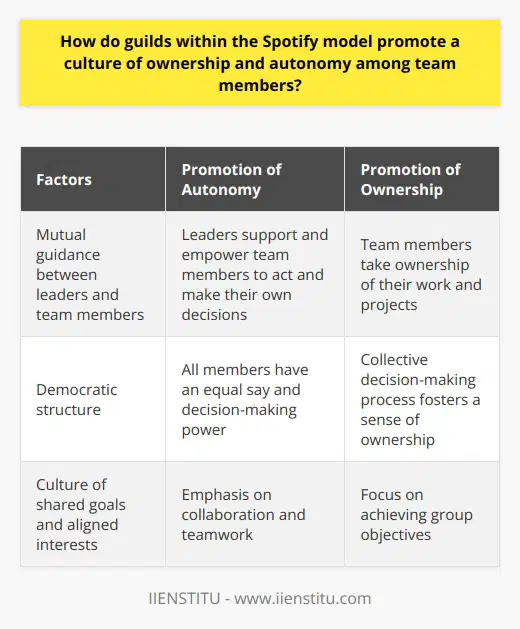
Are there any best practices for effectively organizing and managing guilds in agile environments to maximize their impact and value?
Guild Organization
In agile environments, guilds serve as platforms for enhancing collective knowledge. Effective guild management is crucial in such environments. Efficient organization serves as the first best practice. Regular meetups and constructive dialogue enable knowledge sharing. Autonomy in choosing meeting schedules enhances active member participation.
Knowledge Sharing Techniques
Another best practice involves implementing effective knowledge sharing techniques. Hands-on workshops and seminars increase the application of knowledge. Cross-team collaboration further enhances innovation and problem-solving abilities. Transparent communication channels are vital in this regard.
Structuring for Agility
Structuring the guild for agility is also fundamental. Standardization of practices ensures consistency across the guild. The team should minimize bureaucracy and embrace flexibility. Agile methodologies are particularly crucial when structuring project-specific guilds.
Role Definition
Defining the roles is another key practice. Clear role definitions prevent misunderstandings and overlapping. They also ensure that each member's skills and abilities are maximally utilized. A guild leader should fulfil coordinating and motivating roles effectively.
Guild Evaluation
The evaluation of guilds is as significant as other practices. Regular assessments of the guild’s role in achieving broader business objectives help maintain focus. Assessments also provide insights for improvement and better productivity. Feedback systems should accommodate both individual and collective perspectives.
In conclusion, several best practices exist for managing and organizing guilds in agile environments. Efficient organization, structure for agility, role definitions, knowledge sharing techniques, and regular guild evaluation are some of these. Incorporating them benefits both the guild and the wider organizational framework.
